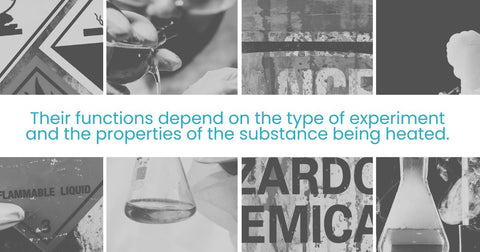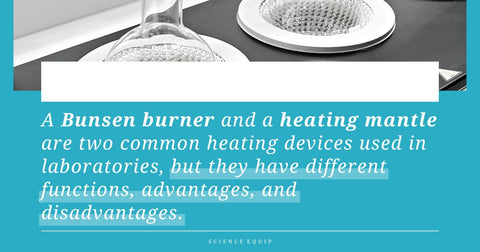If you can buy a Bunsen burner, then do you still need a heating mantle? While the answer lies within your specific laboratory needs, one isn’t better than the other. The way a Bunsen burner functions is by simply using a gas source connected to a barrel, and then they’re ready to go.
They are great, multipurpose tools and the flame output can be adjusted to some degree but lack the finesse and convenience that a heating mantle can have. In this article, you’ll learn the key differences and ultimately make an informed decision when shopping for heating apparatuses.
What is a Bunsen Burner used for?
A Bunsen burner is a laboratory staple that can be found in almost all laboratories. Its primary function is for heating, sterilising, and combustion. They can be adjusted to produce different types of flames, depending on the amount of air that is mixed with the gas. It’s capable of producing high temperatures, where the hottest part of the flame can reach up to 1500°C.
What is a Heating Mantle used for?
A heating mantle is a precise heating tool used with a flask or beaker containing a liquid or a solid using an electric heating element. It is often used in organic chemistry for heating flammable liquids that cannot be heated directly by a flame. A heating mantle can provide uniform and gentle heating, and can be controlled by a thermostat or a Variac. The temperature range of a heating mantle depends on the model, but it can typically reach up to 450°C.
How Do They Work?
Their functions depend on the type of experiment and the properties of the substance being heated. Here are some of the main differences between them:

The Safety
Bunsen burners pose a higher risk of fire and explosion, especially when heating flammable or volatile liquids. Heating mantles are safer because they do not produce an open flame, and they have an enclosed heating system that prevents the escape of vapors. However, heating mantles can still cause burns or electric shocks if improperly handled.
The Efficiency
If we’re talking about energy efficiency, then a Bunsen burner will functionally be more suited for your needs than heating mantles, because they use gas as a fuel source, which is cheaper and more readily available than electricity. Heating mantles consume more power, and they may require additional equipment, such as a transformer or a relay, to regulate the voltage and prevent overheating.
Their Precision
Heating mantles are more precise than Bunsen burners because they provide a constant and accurate temperature, and small increments can adjust them. A Bunsen burner functions by having a twistable collar to adjust the flame’s strength.
Additionally, the gas galve will also dictate how much gas you would want to put into the Bunsen burner. So compared to a heating mantle, they are less precise because the flame's temperature can vary on a number of factors. Moreover, Bunsen burners can cause uneven heating, hot spots, or thermal shock, if the personnel doesn’t know the ideal and proper temperatures needed, thus damaging the flask or the substance being heated.
In Versatility
A bunsen burner function as more versatile lab tools than heating mantles because they can be used for various purposes, such as heating, sterilising, combustion, or melting. They can also be used with different flasks, such as round-bottomed, flat-bottomed, or conical.
Heating mantles can also do the same except for combustion. They are less versatile because they are designed for specific sizes and shapes of flasks (usually round-bottomed). They can also only be used for heating liquids or solids, not other reactions.
The Cost
One of the biggest factors to consider when choosing between a Bunsen burner and a heating mantle is the cost. The average price of a bunsen burner ranges from $50 to $800, depending on the model, features, and quality. The average price of a heating mantle ranges from $300 to $18,000, depending on the size, capacity, and functionality.
Generally, heating mantles are more expensive than bunsen burners because they offer more precise and uniform heating and can accommodate different flasks. However, bunsen burners are more energy-efficient and versatile and can be used for various purposes. Therefore, the cost of the equipment should be weighed against the benefits and drawbacks of either option.
Ease of Maintenance
Another factor to consider when choosing between the two is the ease of maintenance. Both devices require regular cleaning and inspection to ensure proper functioning and safety. However, there are differences in how to maintain them and how much it costs.
A Bunsen burner will retain its functionality longer even if not maintained regularly (although you definitely should). They are relatively easy to maintain, as they only need to be cleaned with a wire brush or a metal file to remove any dirt or residue from the burner head and the gas inlet.
They must also be checked for leaks or cracks in the hose or the valve. They also do not need any special tools or chemicals for cleaning, and they can be soaked in a dishwasher to remove any stubborn deposits (check with your manual or lab supplier if this can be applied to your Bunsen burner).
The maintenance cost for them is low, as they only use gas, which is cheaper and more readily available than electricity. However, bunsen burners may need to be replaced more often if they are damaged by corrosion, overheating, or misuse.
Heating mantles are more difficult to maintain, as they must be cleaned with a damp cloth or a mild detergent to remove any spills or stains from the fabric or the metal casing. They may need some special tools or equipment, such as a transformer or a relay, to regulate the voltage and prevent overheating.
The cost of maintenance is higher, as they consume more power and they may require additional equipment. They may also need to be replaced more often if they are damaged by fire, water, or chemicals. Thus, a professional must also check them for any tears or frays in the fabric, or any exposed wires or heating elements.
In Conclusion

A Bunsen burner and a heating mantle are two common heating devices used in laboratories, but they have different functions, advantages, and disadvantages. Depending on the type of experiment and the substance being heated, one may be more suitable than the other. A Bunsen burner is more versatile, energy-efficient, and easy to maintain, but it poses a higher risk of fire and explosion, and it is less precise and uniform in heating.
A heating mantle is more precise, uniform, and safe, but it is more expensive, power-consuming, and difficult to maintain. Therefore, before buying or using a heating device, one should consider each option's cost, efficiency, precision, versatility, and ease of maintenance, and choose the one that best meets their needs and preferences.Check out about choosing the perfect Bunsen Burner. We also have a comprehensive article about the Heating Mantle before you decide.
